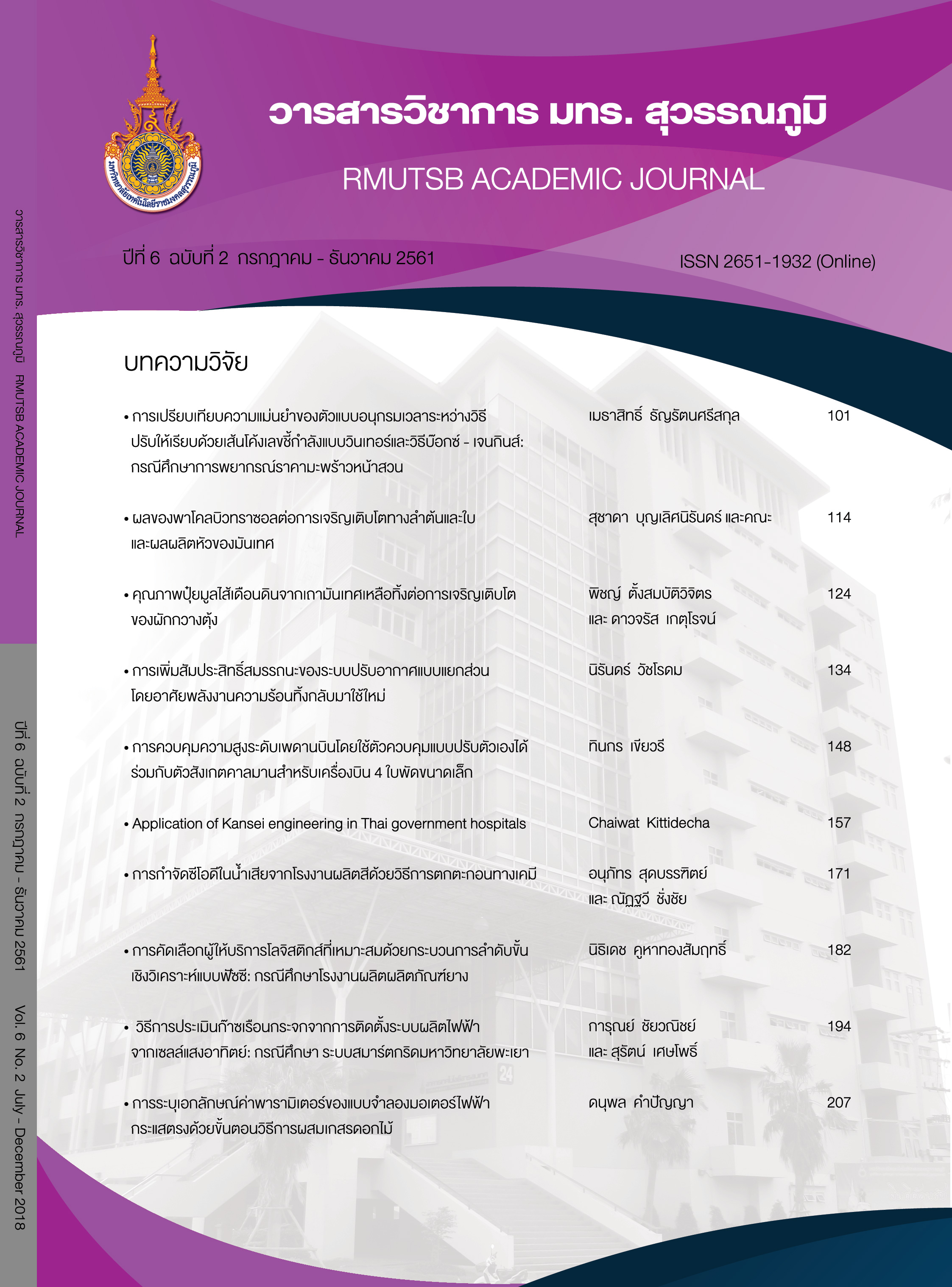The quality of vermicompost from sweet potato crop wastes and its impact on growth promotion of Brassica chinensis
Main Article Content
Abstract
Sweet potato is considered one of the most important economic plants of tambol Tubnam, Pranakorn Sriayutthaya province. Each year, after harvesting season, significant amount of organic wastes from sweet potato stems are left on the field and it could take many years to decompose these wastes to become natural fertilizer. Since vermicomposting technique is a quick and effective way to produce fertilizer with high nutrients. Therefore, the objective of this research is to conduct the experiment on vermicomposting from sweet potato stems using the earthworm Eudrilus eugeniae. To measure the effectiveness of sweet potato stems on vermicomposting, we vermicompost and compost in three different treatments. The results showed that using sweet potato stems for vermicomposting yield higher nutrient content, especially potassium, which increases more than 2.2 times. Finally, to determine the effect of vermicompost on plant growth, all the treatments of vermicompost and compost were applied to Brassica chinensis for 28 days. The results showed that the vermicompost from sweet potato stems outperform the other treatments especially on the average height of the plants. In conclusion, the sweet potato stems are proven to be good sources for vermicomposting.
Article Details
Published manuscript are the rights of their original owners and RMUTSB Academic Journal. The manuscript content belongs to the authors' idea, it is not the opinion of the journal's committee and not the responsibility of Rajamangala University of Technology Suvarnabhumi
References
จุรีรัตน์ ลีสมิทธิ์. (2552). ปฏิบัติการจุลชีววิทยาทั่วไป. กรุงเทพฯ: สำนักพิมพ์มหาวิทยาลัยเกษตรศาสตร์.
นริสรา พานพ่วง, และ สาวิตรี จันทรานุรักษ์. (2555). การศึกษาเปรียบเทียบปริมาณธาตุอาหารหลักของพืชในปุ๋ยหมักธรรมชาติ ปุ๋ยมูลไส้เดือน โดยไส้เดือนดิน Eudrilus eugeniae และปุ๋ยหมัก พด.1. ใน การประชุมทางวิชาการมหาวิทยาลัยเกษตรศาสตร์ ครั้งที่ 50
(น. 442-447). กรุงเทพฯ: มหาวิทยาลัยเกษตรศาสตร์.
สกุลเทพ ชูพงษ์, กิตติ บุญเลิศนิรันดร์, และพิชญ์ ตั้งสมบัติวิจิตร. (2559). การศึกษาศักยภาพการผลิตปุ๋ยมูลไส้เดือนดินดินจากผักตบชวาบริเวณคลองส่งน้ำในจังหวัดพระนครศรีอยุธยา. ใน การประชุมวิชาการระดับชาติมหาวิทยาลัยเทคโนโลยีราชมงคลสุวรรณภูมิ ครั้งที่ 1 (น. 519-524). พระนครศรีอยุธยา: มหาวิทยาลัยเทคโนโลยีราชมงคลสุวรรณภูมิ.
อานัฐ ตันโช. (2552). คู่มือการผลิตปุ๋ยหมักมูลไส้เดือนดินจากขยะอินทรีย์. เชียงใหม่: Trio Advertising & Media.
Gajalakshmi, S., & Abbasi, S. A. (2004). Earthworms and vermicomposting. Indian J. Biotechnol, 3, 486-494.
Klangkongsub, S., & Sohsalam, S. (2013). Vermicompost production by using tomato residue and yard waste. Journal of Medical and Bioengineering, 2, 270-273.
Lv, B, Xing, M, Yang, J., & Zhang, L. (2015). Pyrosequencing reveals bacterial community differences in composting and vermicomposting on the stabilization of mixed sewage sludge and cattle dung. Applied Microbiology and Biotechnology, 99, 10703-10712.
Orozco, F. H., Cegarra, J., Trujillo, L. M., & Roig, A. (1996). Vermicomposting of coffee pulp using the earthworm Eisenia fetida: effects on C and N contents and the availability of nutrients. Biology and Fertility of Soils, 22, 162-166.
Prasitket, J, Chuvorrivate, N., Ruengnab, M., Padung, T., Choulvanapong, P., & Reanjareang, S. (2005). Organic fertilizer: Production, utilization and quality. Bangkok: Department of Agriculture.
Sailila, N., Bakar, A. A., Mahmood, N. Z., Siliva, J. T., Abdullah, N., & Jamaludin, A. A. (2010). Nutrient elements of different agricultural wastes from vermicomposting activity. Dynamic Soil, Dynamic Plant, 4, 155-158.
Schirmer, W. N, Jucá, J. F. T., Schuler, A. R. P., Holanda, S., & Jesus, L. L. (2014). Methane production in anaerobic digestion of organic waste from Recife (Brazil) landfill: evaluation in refuse of different ages. Brazilian Journal of Chemical Engineering, 31, 373-384.
Sinha, R. K., Agarwai, S., Chauhan, K., & Valani, D. (2010). The wonders of earthworms & its Vermicompost in farm production: Charles Darwin’s friends of farmers’ with potential to replace destructive chemical fertilizers from agriculture. Agricultural Sciences, 1, 76-94.
Tangsombatvichit, P, Chupong, S., Ketrot, D., & Boonlerthirun, K. (2016). The management of organic wastes produced vermicompost using earthworm Eudrilus eugeniae and effects of vermicompost on growth of Helianthus annuus. In 5th International conference on food, Agricultural and Biological Sciences (ICFABS-2016) (pp. 1-4). Thailand: International Association of Chemical, Biological & Medical Sciences Researchers.
Vivas, A., Moreno, B., Garcia-Rodriguez, S., & Benitez, E. (2009). Assessing the impact of composting and vermicomposting on bacterial community size and structure, and microbial functional diversity of an olive-mill waste. Bioresource and Technology, 100, 1319-1326.
Walkley, A., & Black, I. A. (1934). An examination of the Degtjareff method for determining soil organic matter, and a proposed modification of the chromic acid titration method. Soil Science, 37, 29-38.


